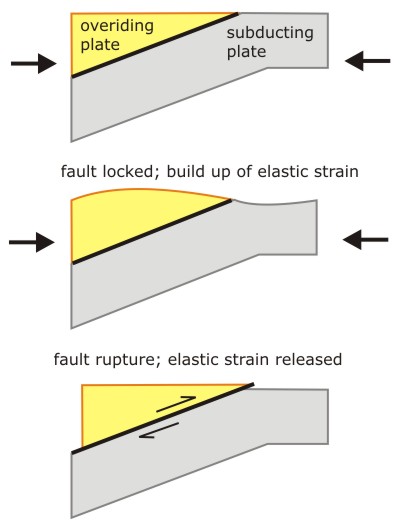Riffing off Kim’s comment on my brief post on the Japanese earthquake, I thought that I’d talk a little bit more about how the first, shallow, nuclear power plant-shaking earthquake fits into the overall tectonic picture for Japan, because it touches upon a couple of concepts that I’m particularly interested in.

The figure above shows that Japan is right on top of not one, not two, but three plate boundaries; the Pacific, Eurasian and Philippine plates all jostle against each other at a single point – a triple junction – off the coast of central Honshu. This additional complexity is not particularly important for the current discussion, because both of the plate boundaries running parallel to the Japanese coast consist of subduction ‘megathrusts’, along which oceanic crust is being pushed westward underneath Japan and back into the mantle. The only difference is that the oceanic crust being subducted beneath the coast of southern Japan belongs to the Philippine plate, and the crust being subducted beneath northern Japan belongs to the Pacific plate. The figure also shows the location of Monday’s first earthquake, km behind the trench which marks the plate boundary. The rupture depth of 8 km locates it firmly in the overriding plate, rather than in the subducting slab; yet the sense of movement revealed by the moment tensor solution indicates SE-NW compression, which is exactly in line with the relative plate motion vector between the Philippine and Eurasian plates. Previous earthquakes in this area show exactly the same thing, and as we’ll see, this is probably no coincidence.
As I probably don’t need to tell you, the basic cause of all earthquakes is the fact that rocks on opposite sides of a fault do not slide smoothly past each other; there is usually a large amount of friction across the plate interface, which has to be overcome before it moves. While the fault is stuck, the region around it deforms elastically to accommodate the continuing plate motions; eventually, when enough elastic strain builds up to overcome the frictional forces, the fault ruptures and produces and earthquake.

Between earthquakes on a large fault, then, a sizable area around it is moving and bending as it stores elastic strain. Most of this deformation is temporary, and is eventually turned into motion on the main fault when it ruptures. But when continental crust is involved, this isn’t necessarily the case, for two reasons. Firstly, continental crust is intrinsically quite weak; it is relatively easy to fracture it and form new faults. Secondly, it has memory. Because continental crust is extremely difficult to subduct, and can therefore be hundreds of millions or even billions of years old, it has often been subjected to multiple episodes of deformation. If you examine such crust closely, you will see the scars of this long and turbulent history: old faults, which can be pressed back into service to accommodate new plate motions.
And this is probably what is happening in Japan: between ruptures on the subduction thrust, shortening across the plate boundary is being transferred into the overriding plate. But not all of it stays stored as elastic strain; instead, some of it is permanently accommodated by reverse faulting on the west coast of Honshu. Are these new faults, or old ones? I don’t know, but it’s possible that you’d find old extensional faults in this area, related to the opening of the Japan Sea, and that these are being reactivated.
An important question is whether this has any impact on the seismic hazard associated with the subduction thrust. Sadly, whilst deformation in the overriding plate reduces the total amount of plate motion which needs to be accommodated at the plate boundary itself, and hence possibly increases the time between earthquakes there, the size of those earthquakes is much more dependent on the characteristics of the subduction boundary itself, like its overall frictional strength. So it would be wrong to view this seismicity away from the trench as any sort of safety valve. Let’s just hope that Harold is wrong about the Japanese approach to quake-proofing their nuclear power plants…



Comments (4)